


Recrystallization of sulphur from toluene
It is fairly well known that sulphur is somewhat soluble in toluene, but it is much less known that the solubility in toluene is strongly depending on the temperature of the solution. When the solution is cold, then only 1 to 2 grams per 100 ml of toluene can be dissolved, but when the solution is hot, then approximately 20 grams of sulphur can be dissolved in toluene. This is quite remarkable, mostly, because there hardly seem to be any solvents, available for the general public in which sulphur can be dissolved to any reasonable extent.
When the solution cools down, then nice needle-like and somewhat transparent crystals of sulphur are formed. These crystals become quite large.
![]() In this experiment, a solution of toluene is heated to almost 100 °C. Never
do this with a flame, but use boiling or near-boiling water. One can boil
some water in a pan and take this pan from the fire and immerse the test tube in
the hot water, with no open flame nearby.
In this experiment, a solution of toluene is heated to almost 100 °C. Never
do this with a flame, but use boiling or near-boiling water. One can boil
some water in a pan and take this pan from the fire and immerse the test tube in
the hot water, with no open flame nearby.
![]()
![]() Required
chemicals:
Required
chemicals:
-
sulphur powder
-
toluene (technical quality from hardware stores is OK).
![]() Required
equipment:
Required
equipment:
-
test tubes with rubber stopper
-
pan
![]() Safety:
Safety:
- Toluene is harmful and one should avoid inhaling too much of the toluene vapor.
- Toluene is flammable, especially, when it is hot, due to high vapor pressure.
![]() Disposal:
Disposal:
- The toluene should not be flushed down the drain. If the amount is just a few ml, put it on a dry paper tissue and let it evaporate outside and put the dry paper tissue in the ordinary household waste. If larger quantities are used, then the toluene should be brought to a proper waste processing facility.
![]()
Dissolving sulphur in toluene
This experiment in fact is very simple. It is not added here as a chemical experiment, but it is shown how sulphur can be recrystallized and refined, when it is impure.
![]() Take a big spatula full of sulphur, intended for gardening
purposes. Frequently this contains a little amount of calcium carbonate and some
other impurities. If flowers of sulphur are used, then much less impurities can
be expected. The amount taken was almost 200 mg.
Take a big spatula full of sulphur, intended for gardening
purposes. Frequently this contains a little amount of calcium carbonate and some
other impurities. If flowers of sulphur are used, then much less impurities can
be expected. The amount taken was almost 200 mg.
![]() Add approximately 3 ml of toluene to the sulphur. Stopper
this test tube loosely with a rubber stopper.
Add approximately 3 ml of toluene to the sulphur. Stopper
this test tube loosely with a rubber stopper.
![]() Prepare a pan with boiling-hot water and immerse the lower
part of the test tube in it. Sometimes shake a little. When all is quite hot,
then firmly press the stopper in the test tube. Now keep the test tube in the
hot water for a while and shake. What will be observed is that the sulphur
dissolves. If gardening sulphur is used, then some impurities may remain. The
liquid becomes yellow.
Prepare a pan with boiling-hot water and immerse the lower
part of the test tube in it. Sometimes shake a little. When all is quite hot,
then firmly press the stopper in the test tube. Now keep the test tube in the
hot water for a while and shake. What will be observed is that the sulphur
dissolves. If gardening sulphur is used, then some impurities may remain. The
liquid becomes yellow.
![]() Now take the test tube out of the water and make it dry with
a towel and as quickly as possible pour the clear liquid in another test tube,
assuring that any insoluble matter is not poured in the second test tube.
Now take the test tube out of the water and make it dry with
a towel and as quickly as possible pour the clear liquid in another test tube,
assuring that any insoluble matter is not poured in the second test tube.
![]() Allow the second test tube to cool down. Nice crystals of
very pure sulphur separate from the liquid. Almost immediately, some light
yellow crud is formed at the bottom of the test tube. This is shown in the
picture below.
Allow the second test tube to cool down. Nice crystals of
very pure sulphur separate from the liquid. Almost immediately, some light
yellow crud is formed at the bottom of the test tube. This is shown in the
picture below.
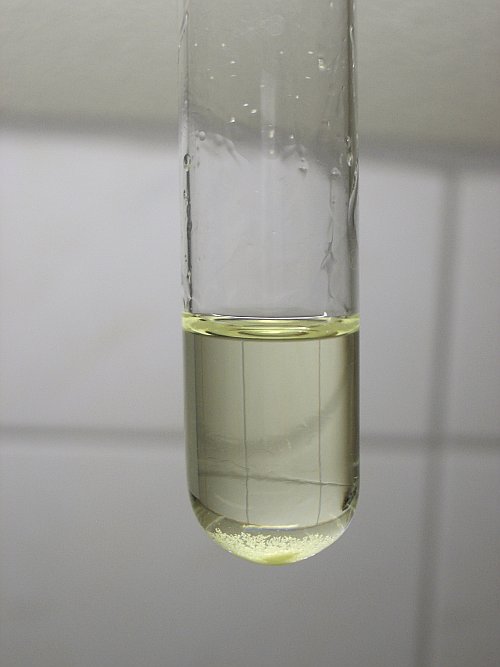
More sulphur separates from the liquid in the course of several minutes. The following three pictures show this.
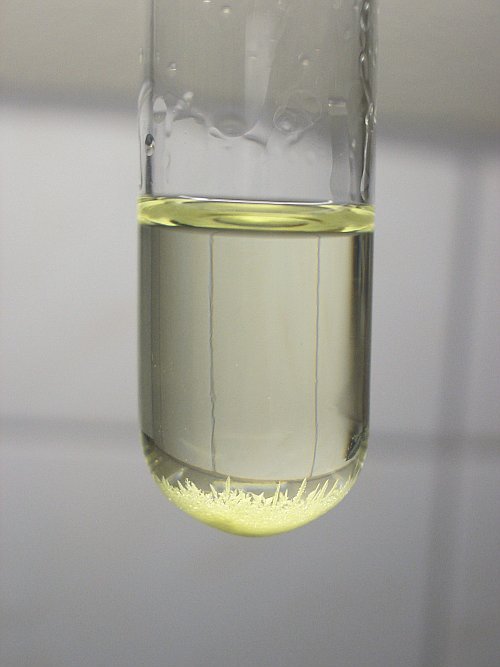
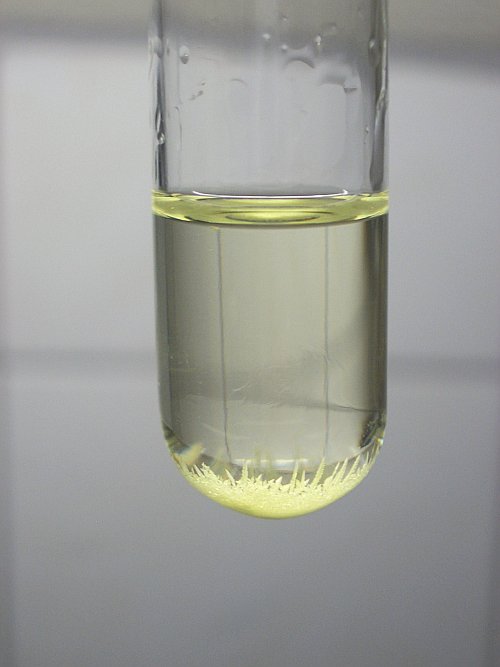
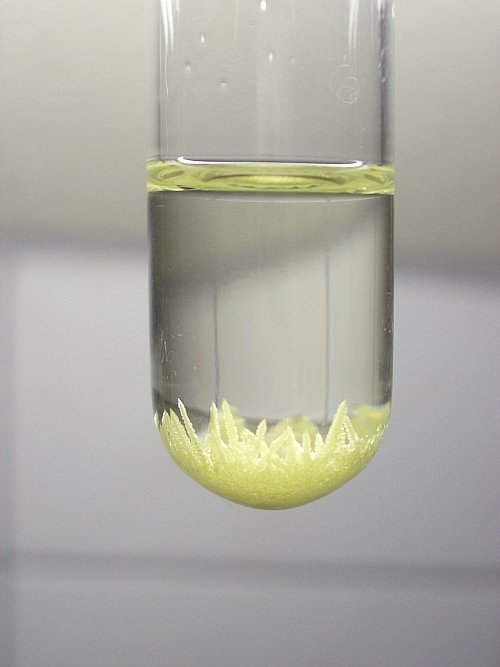
The final result is the following. It shows nice needle-shaped crystals of sulphur in the toluene.
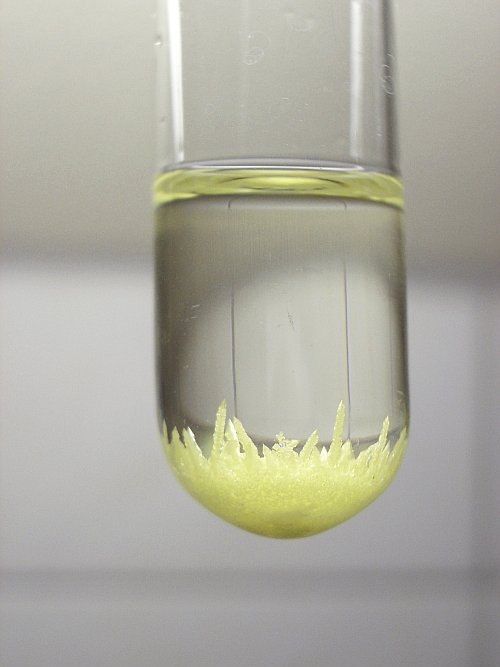
![]() When the
crystals do not grow anymore, then one can put the test tube in a refrigerator
for further cooling, but for this experiment, it was decided to stop, when the
growing of crystals ceased. The toluene was decanted from the sulphur crystals
carefully and the crystals were tapped out of the test tube on a small piece of
filter-paper and allowed to dry at air contact.
When the
crystals do not grow anymore, then one can put the test tube in a refrigerator
for further cooling, but for this experiment, it was decided to stop, when the
growing of crystals ceased. The toluene was decanted from the sulphur crystals
carefully and the crystals were tapped out of the test tube on a small piece of
filter-paper and allowed to dry at air contact.
The crystals are very nice and shiny and they have a bright yellow color, much brighter than the initial powder. The following picture shows the crystals of sulphur on a piece of white paper. The total amount is a little over 150 mg, so 75% was retrieved as pure crystals. The yield can be increased somewhat by further cooling of the liquid.
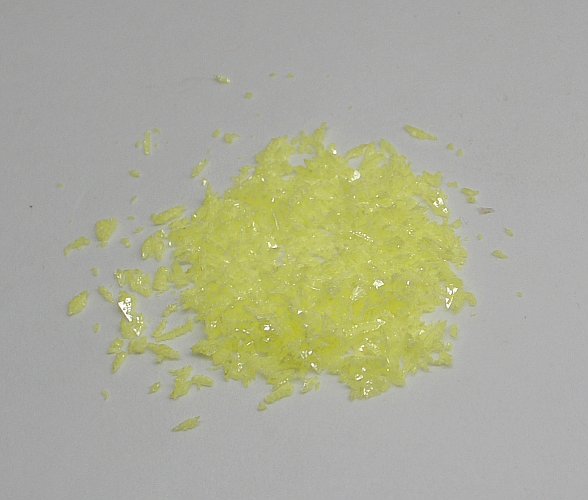
The picture shows that the crystals are nice and shiny and they are a little transparent. The next picture shows the same sample, put in a little glass vial. This shows the bright yellow color of the crystals.
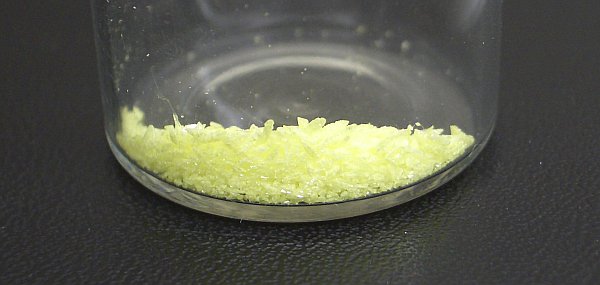
![]()
Remarks
This procedure can be scaled up safely, as long as one is capable to handle the risk of fire and the vapor of the toluene. It can be used to grow nice large crystals of sulphur and it can also be used to purify commercial sulphur.
Many commercial forms of sulphur contain impurities. Almost certainly these impurities do not dissolve in toluene, so with this method one can very easily get rid of the impurities.
Toluene can be obtained easily at many hardware stores.